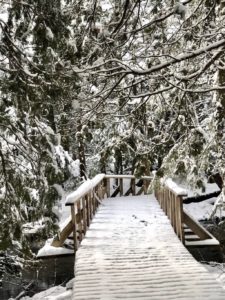THE LAND & COMMONS
The Geology and Habitats of Cedar Valley Ridge
by Kerry Kelly
CVR resident, former chair of the Friends of Sleeping Bear Dunes
One of the primary attributes of the Cedar Valley Ridge topographical landscape that appeals to me is the trails in the shared common area. I can go outside my home and walk, snowshoe, or ski right onto the trails. I love the great exercise the hills and valleys provide when I hike or snowshoe, and welcome a bit of challenge when I cross-country ski.
The Cedar Valley Ridge landscape creates micro-habitats that provide a great diversity in plant and animal populations. For example, we have some of the absolute best spring wildflower habitats in northern Michigan. In springtime, the hillsides are covered in a carpet of trillium, Dutchman’s breeches, squirrel corn, bellwort, spring beauty, hepatica, violets, lady slippers, and many other flowering plants through summer into the fall. The lowland area along Cedar Run Creek hosts a wide variety of wetland species of plants and flowers, as well as a variety of songbirds, hawks, woodpeckers, and ravens. The surrounding forest serves as home to deer, fox, coyotes, turkeys, squirrels, rabbits, raccoons, porcupines, and even an occasional mink.
The geology and topography of Northern Michigan are the results of several periods of glaciation over the past million years. The last glacier to impact our area, known as the Wisconsin glacier, receded about 10,000 years ago. As the glacier-formed and moved south from the Canadian Shield, it brought with it a mixture of boulders, gravel, and sand that was deposited and is referred to as glacial moraine.
In some areas, huge blocks of ice remained as the glaciers receded. When this ice melted, steep valleys, hills, and holes were carved into the landscape. The most uniform, cone-shaped holes are called kettles. There are several excellent examples of kettle moraine in the common area of CVR. Sometimes, as is the case in one special kettle at CVR, a layer of clay on the bottom of the kettle allows standing water to accumulate and a bog or wetland developed.
This glacial landscape was eventually stabilized by vegetation and became densely forested. Today, the rolling ridges at Cedar Valley Ridge are home to a lush, diverse forest of maple, oak, beech, white pine, ironwood, witch hazel, hemlock, and tamarack as well as numerous varieties of native bushes, plants, and grasses. This diversity continues well beyond the 177 acres that comprise Cedar Valley Ridge. Nearby are hundreds of acres of Michigan State land which also reflect this dramatic natural ecology.
The diverse natural environment of Cedar Valley Ridge is simply enchanting!
COMMON AREA / TRAILS
Over seven miles of maintained trails
 At Cedar Valley Ridge you will find over seven miles of beautiful, private, peaceful hiking trails. We built the trails to highlight as much of the natural attributes of the land as possible: the wide variety of wildflowers, steep hills and open meadows, many outstanding tree species, the enchanted riparian valley of Cedar Run Creek. The trails that wind through the neighborhood are private. You won’t have to worry about bumping into strangers. No motorized vehicles, no horses – just your neighbors. You can walk in the pines, amble through hardwood forestland, or immerse yourself in the setting of the creek. Occasionally, you might want to join some of your neighbors in clearing brush from the trails – or not. It’s lots of fun and a great way to socialize and exercise!
At Cedar Valley Ridge you will find over seven miles of beautiful, private, peaceful hiking trails. We built the trails to highlight as much of the natural attributes of the land as possible: the wide variety of wildflowers, steep hills and open meadows, many outstanding tree species, the enchanted riparian valley of Cedar Run Creek. The trails that wind through the neighborhood are private. You won’t have to worry about bumping into strangers. No motorized vehicles, no horses – just your neighbors. You can walk in the pines, amble through hardwood forestland, or immerse yourself in the setting of the creek. Occasionally, you might want to join some of your neighbors in clearing brush from the trails – or not. It’s lots of fun and a great way to socialize and exercise!
Trails are marked at key intersections…no getting lost!
